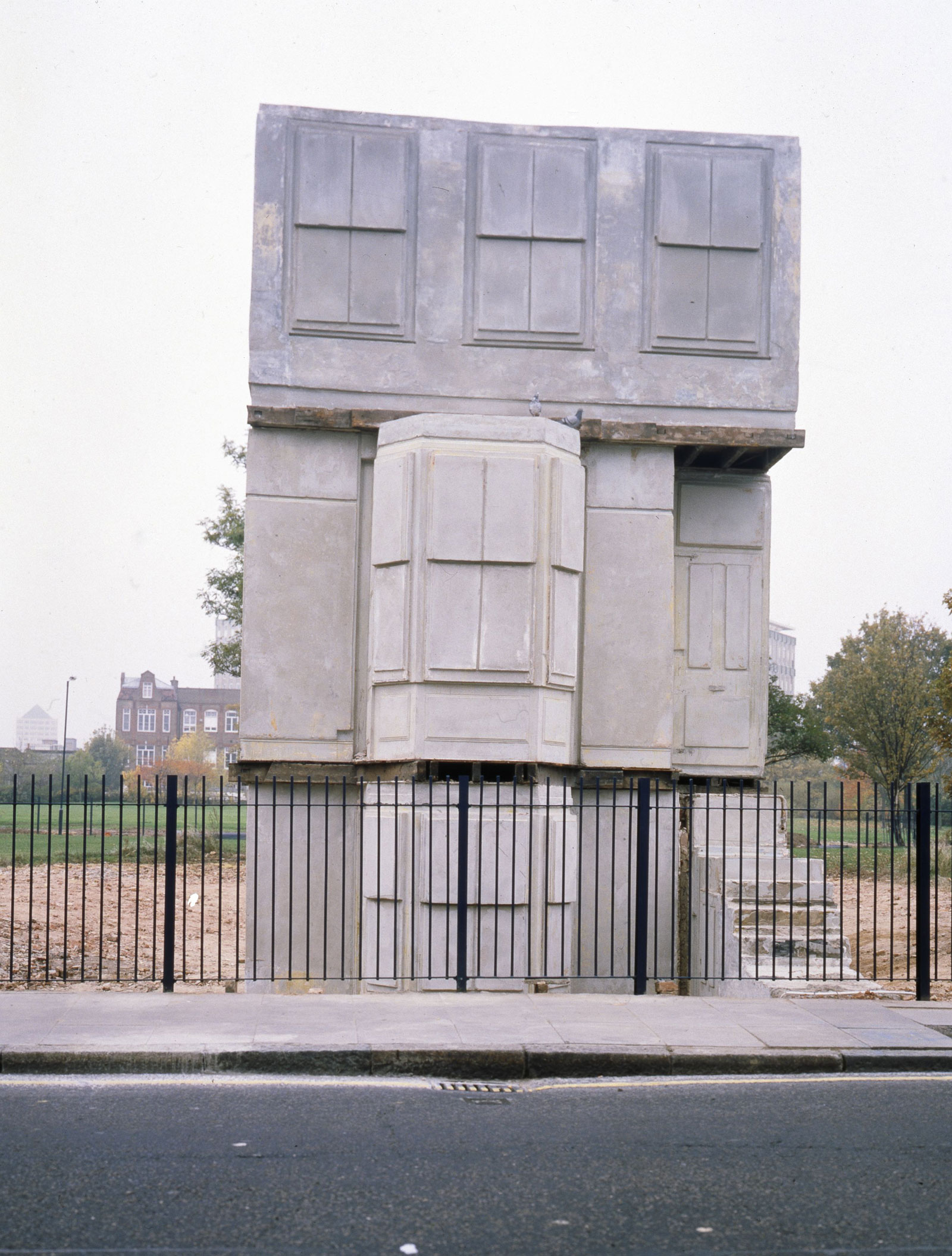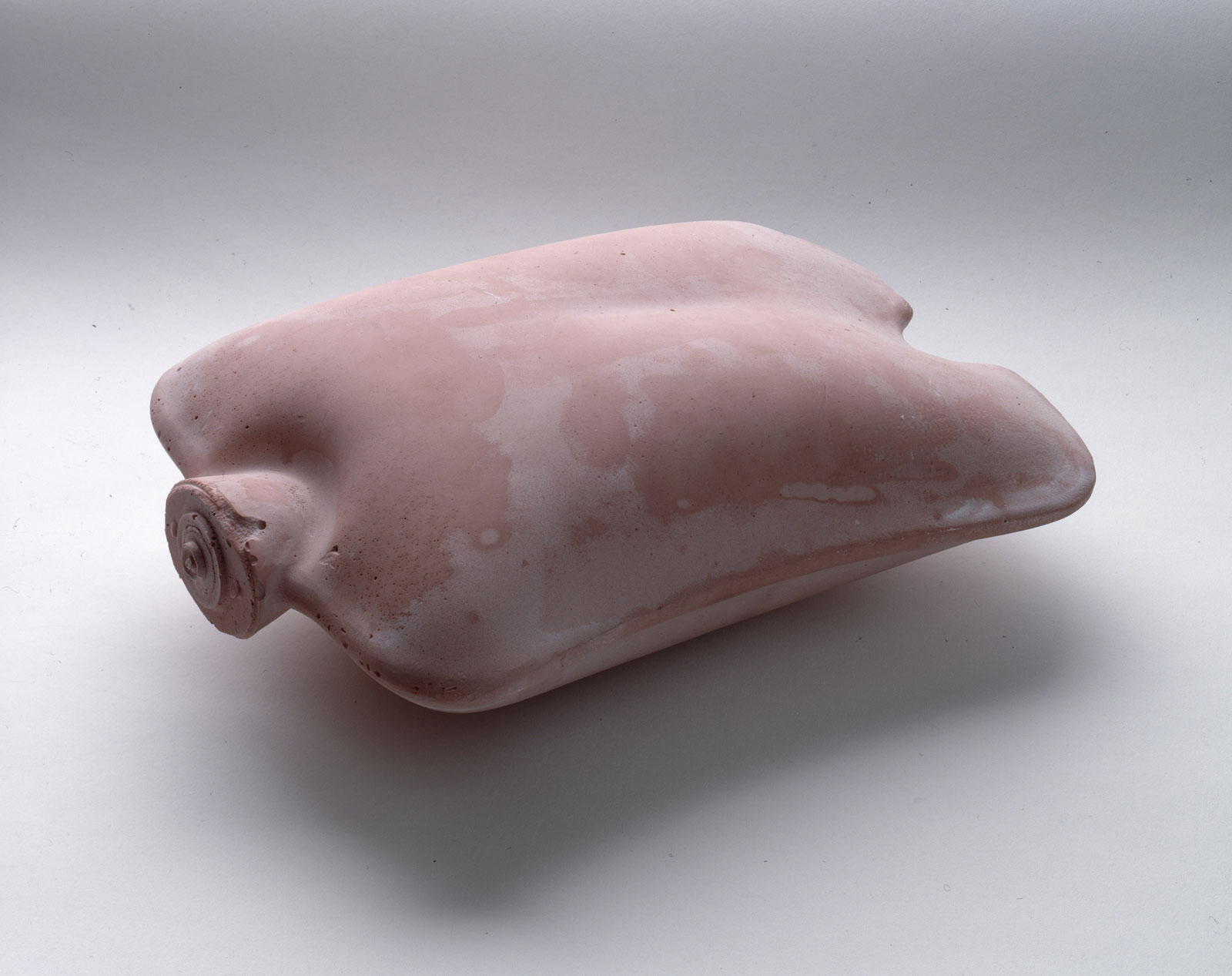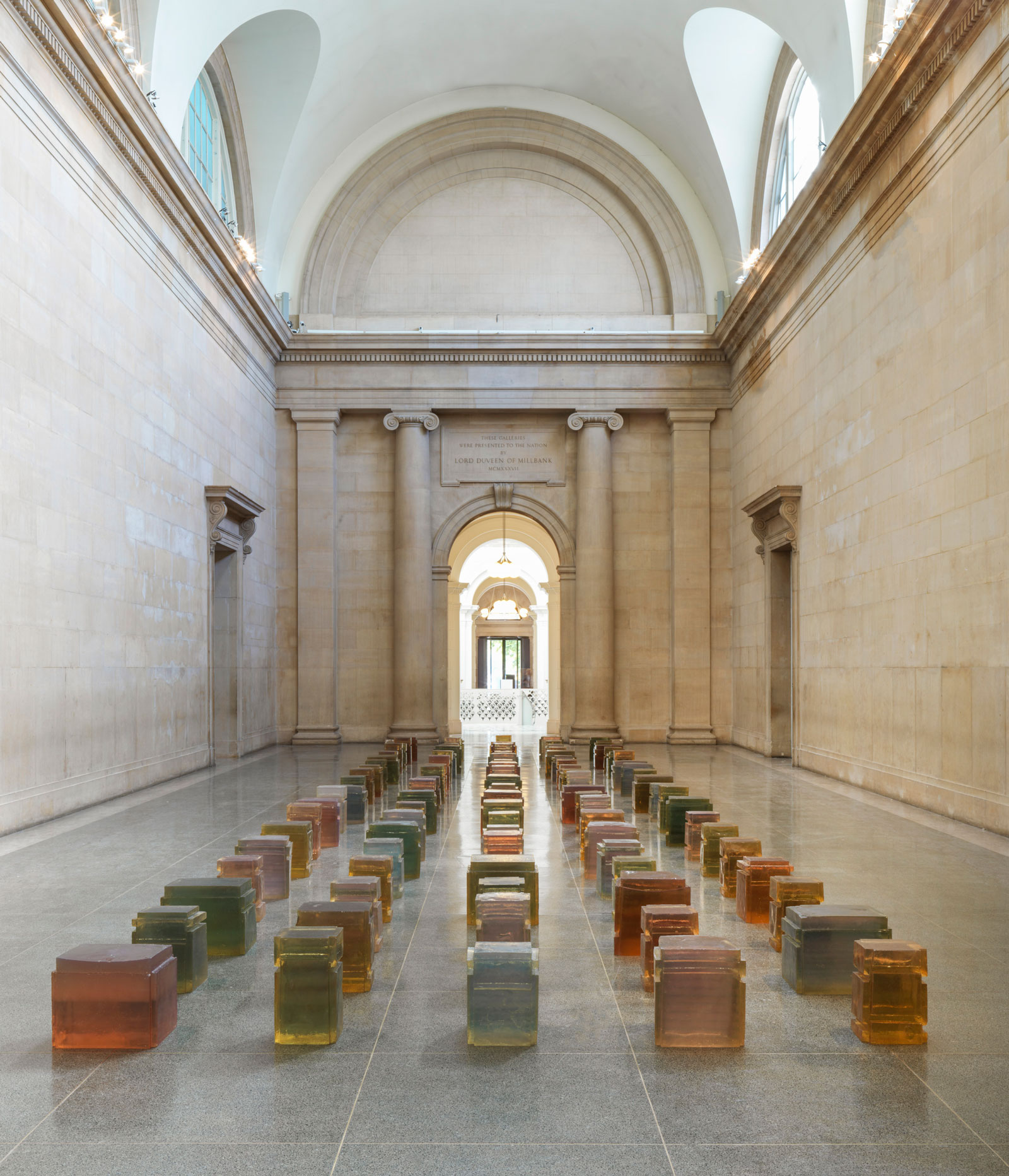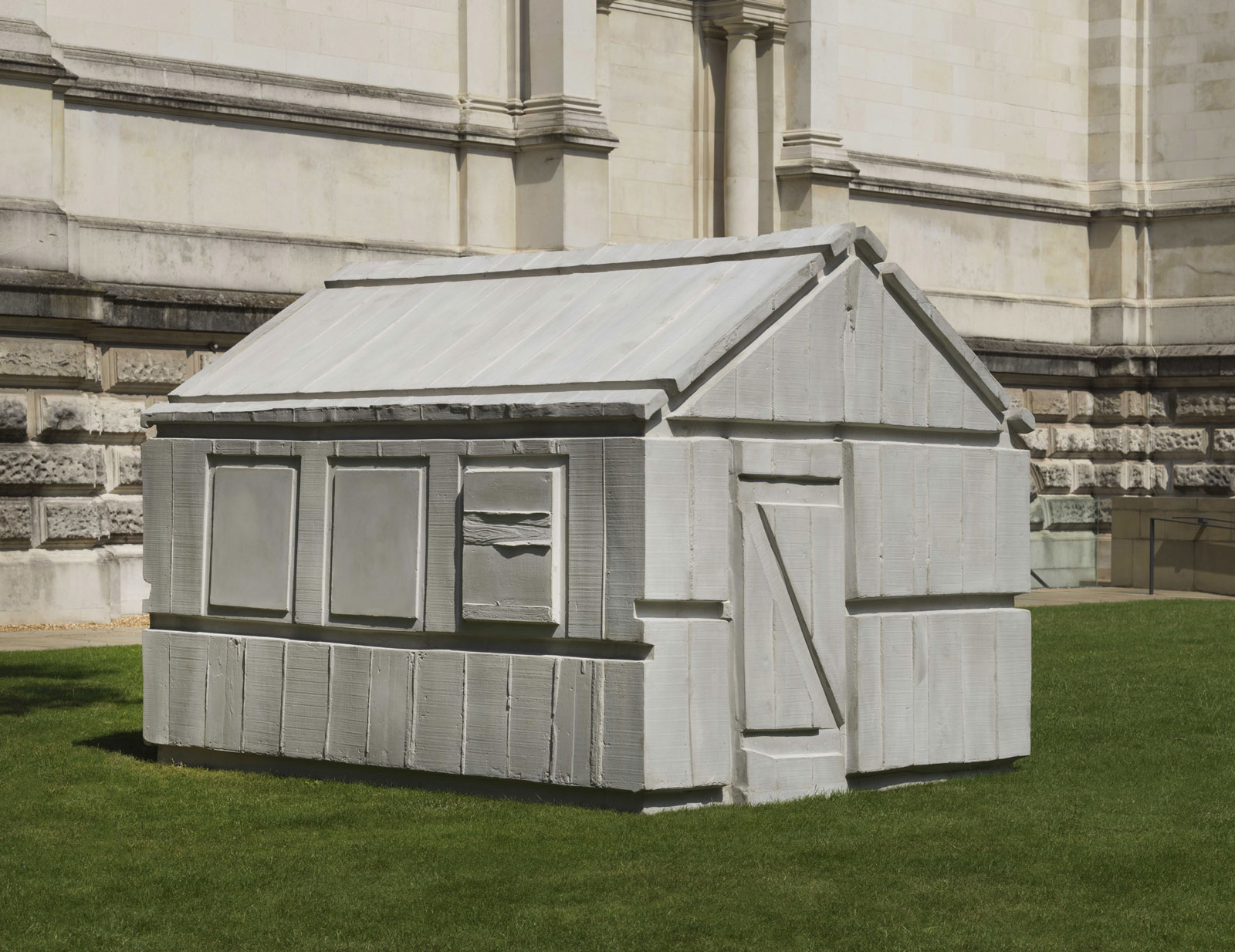There’s something cool yet passionate about Rachel Whiteread’s work. It is calmly paradoxical, domestic but monumental, tactile but detached, nostalgic but austere: objects and dwellings from everyday lives are lifted to a different sphere, a dance in space. Mattresses slump against walls; stairs rotate, rising almost to the ceiling; dark slabs of resin march along the floor. In a new exhibition celebrating twenty-five years of her career as an artist, Tate Britain has removed the partitions that usually divide separate rooms, creating a huge open space with white walls and glowing, pale wood floor. This has a curious effect, making the people walking between the exhibits seem part of the show itself, and indeed this is oddly appropriate as—though no human form is represented—Whiteread’s work has always been about bodies and people and the way we live. She asks us to see things we know—tables and chairs, the inside of a room—from the opposite of our normal perspective, looking at the space instead of the walls, the gaps instead of the frames, making the air itself solid.
Whiteread sprang to fame in 1993 with House, the concrete cast of the inside of a small terraced house, 193 Grove Road, in Bow, East London. The whole terrace was due to be demolished as part of Thatcher’s plan for a “green corridor” around the new skyscrapers of Canary Wharf a few miles to the south. Whiteread, then in her late twenties, had a studio nearby, and as she cycled past, she knew that the whole area would change. House was, in part, an attempt to capture time, a way of living that would soon vanish. She had already made a cast of the interior of a London bedsit, and now, with the art-co-operative Artangel, she took on the enormous task of a whole house. When it was done, the cast released from its carapace of bricks, it stood like a solid spectre of its former self with every detail marked, even the back of fireplaces sticking out into the air. I remember seeing it, pale in the autumn daylight, brilliantly illuminated in the dark evenings. Reactions were furiously divided. Some critics saw a work of genius, others a monstrous block. One graffiti writer scrawled “WHAT FOR?” on its blank walls. Another answered, “WHY NOT?” Crowds came to see it. That fall, Whiteread won the Turner Prize, the first woman to do so. On the night she received the award, the news came of the local council’s decision to demolish the sculpture. Less than a week later, despite public outcry, it was razed. It stood for only eighty days, but its impact was profound.
Just outside the entrance to the current show, a video shows the creation of House, a landmark in all senses. The most striking thing is how complicated and difficult the process was of stripping out fittings, pouring in concrete, chipping off bricks. As I walked through the show, I was reminded often of the sticky, messy, labor-intensive effort of creation and the sheer technical ambition that went into the creation of Whiteread’s serene, still objects: the squeezing of different fillings into hot-water bottles to make eerily touching versions of Torso, the applying of thick casts to doors and windows, transforming them into objects of translucent beauty, entries to another world. And then, at the very end of the exhibition, the mess is suddenly made visible again, in shed sections cast from papier maché, where the colors of the pulped greeting cards, invitations, wrapping paper, and newsprint burst out in blobs and streaks of red and blue and green, and the whole is sometimes covered in a delicate tracery of paint. In these works, the artist turns back to the material in which she first began to work, and to her own beginnings as a painter. That kind of return is typical, like her use of resin to catch the grain of wood on the floors, the scratches and chips and lost footsteps of the past. She always thought, she said in an interview in 2005, that floors “were like the bowels of a house, like the hidden corners no one ever sees.”
Early work shown at the start of the exhibition, made soon after she graduated from the Slade School of Art, suggests that we also fail to see the most banal and workaday objects. A cast of an ordinary bath, complete with plughole, is set in a high block that means you have to stand on tiptoe to gaze into it. (Or short people like me do.) Daily existence takes on an art-life of its own in casts of an oven, a sink, a black cupboard hinting at dark secrets, or a squashed old mattress. From the mid-1990s, following the lead of Bruce Nauman’s 1968 A Cast of the Space Under My Chair and his idea of “negative space,” Whiteread also made casts of the underside of chairs and tables. Ranks of such chair-spaces in subtly coloured resin formed one of Whiteread’s first major installations, Untitled (One Hundred Spaces), and in an inspired curatorial move, these are lined up beneath the imposing dome of the Tate’s Duveen Gallery, glowing like jellied sweets. The use of resin is particularly evocative because you can’t help peering through, or into, the form, as if expecting to find something, or someone, inside, or to see the structure beyond. One of the most haunting exhibits, aptly called Ghost (a title Whiteread often uses in different variations), is a near-transparent tabletop model of a whole house, perhaps a doll’s house, conjuring a sense of invisible life within.
Advertisement
There are larger haunted spaces here, too, notably the temple-like concrete cast of Room 101 (2003), the office at the BBC where George Orwell sat through tedious meetings and which he used as a model for the torture chamber in 1984, where prisoners meet their own nightmares. It’s uncanny to walk around it and find no way in to this room full of fears. In many cases, as here, Whiteread’s art at once invites and denies our presence. In this sense, the most moving exhibit in the exhibition is a trio of “book-corridors,” shelves where books once stood, their spines facing inward; we can still see the outline of their shapes and their rough page edges, but the books themselves have gone. This idea formed the basis for Whiteread’s Holocaust Memorial in the Judenplatz in Vienna (2000), whose dignified, unforgiving slab-like structure is made up of ranks of such bookshelves, a tribute to countless Austrian Jews, their stories untold but their shades remembered.
Whiteread’s other public commissions are recorded in a line of photographs in the space just outside the show itself. Here is the transparent resin cast of Water Tower (1998), which turned one of the myriad rooftop water-towers of New York, taken for granted and ignored, into a shimmering jewel. Here is Monument (2001), Whiteread’s creation of a resin plinth to mirror and stand on top of the empty plinth in Trafalgar Square, a wry comment on official memorials of the great and good. The images are powerful, yet something is lost by seeing these works in two-dimensional form: you long to be there to feel their strange solidity, their relation to the space, and the air. Recently, her Shy Sculptures of boathouses, sheds, and wooden shacks have found a home in lonely, remote places: on the rocky coast of Norway; gazing across at the Statue of Liberty and the Manhattan skyline from the shore of Governor’s Island; crouching among the cacti of the Mojave Desert. Finally, and far from remote, a little Chicken Shed (2017) squats outside Tate Britain itself. Solid as they are, these sheds, like all Whiteread’s works, transform our sense of “ordinary” lives. One of her casts, a trio of windows created in 2012, in gleaming blue and green tints, is titled LOOK, LOOK, LOOK. An irresistible command, from a visionary artist.
“Rachel Whiteread” is at the Tate Britain through January 21.







